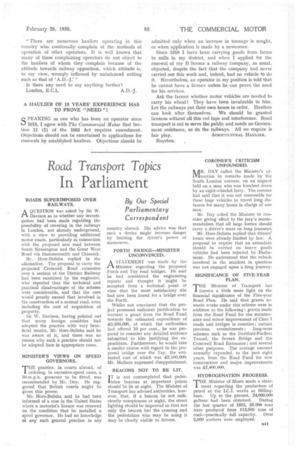Road Transport Topics
Page 55

If you've noticed an error in this article please click here to report it so we can fix it.
In Parliament
By Our Special Parliamentary Correspondent
ROADS SUPERIMPOSED OVER RAILWAYS.
A QUESTION was asked by Sir W. I" I. Davison as to whether any investigation had been made regarding the possibility of covering in the railways in London, not already underground, with a view to providing additional motor roads, particularly in connection with the proposed new road between South Kensington and the Great West Road via Hammersmith and Chiswick.
Mr. Hore-Belisha replied in the affirmative. The proposal to carry the projected Cromwell Road extension over a section of the District Railway had been examined by the engineers, who reported that the technical and practical disadvantages of the scheme were considerable, and that the cost would greatly exceed that involved in the construction of a normal road, even including the cost of acquisition of property.
Sir W. Davison, having pointed out that ma ny foreign countries had adopted the practice with very beneficial results, Mr. Hore-Belisha said he was aware of it, and there was no reason why such a practice should not be adopted here in appropriate cases.
MINISTER'S VIEWS ON SPEED GOVERNORS.
THE practice, in courts abroad, of ordering, in excessive-speed cases, a 30-m.p.h. governor to be fitted, was recommended by Mr. Day. He suggested that British courts might be given this power.
Mr. Hore-Belisha said he had been informed of a case in the United States where a motorist's licence was renewed on the condition that he installed a speed governor. He had no knowledge of any such general practice in any ASTATEMENT was made by the .Minister, regarding the proposed Forth and Tay road bridges. He said he had considered the engineering reports and thought it might be accepted from a technical point of view that the most satisfactory site had now been found for a bridge over the Forth.
Whilst not convinced that the project possessed sufficient justification to warrant a grant from the Road Fund towards the estimated expenditure of £3,250,000, of which the authorities had offered 10 per cent., he was prepared to consider any detailed evidence submitted to him justifying the expenditure. Furthermore, he would take a similar course with regard to the proposed bridge over the Tay, the estimated cost of which was 42,100,000. Mr. Mathers expressed disappointment.
BEACONS NOT TO BE LIT.
I T is not contemplated that pedes
triantrian beacons at important points should be lit at night. The Minister of Transport has advised authorities, however, that, if a beacon be not sufficiently conspicuous at night, the street lighting should be improved so that not only the beacon but the crossing and the pedestrians who may be using it may be clearly visible to drivers.
NfiR. DAY called the Minister's at1Vitention to remarks made by the South London coroner, on an inquest held on a man who was knocked down by an eight-wheeled lorry. The coroner had said that it was not reasonable for these huge vehicles to travel long distances for many hours in charge of one man.
Mr. Day asked the Minister to consider giving effect to the jury's recommendation that all large lorries should carry a driver's mate on long journeys.
Mr. Hore-Belisha replied that drivers' hours were already limited by law. A. proposal to require that an attendant should he carried on heavy goods vehicles had been rejected by Parliament. He understood that the vehicle involved in the accident in question was not engaged upon a long journey.
SIGNIFICANCE OF FIVE-YEAR
THE Minister of Transport has thrown a little more light on the financial significance of the Five-year Road Plan. He said that grants towards works under this scheme were in addition to the following: grants made from the Road Fund for the maintenance and minor improvement of Class I roads and bridges in counties ; certain previous commitments ; long-term schemes such as the Dartford-Purfieet Tunnel, the Severn Bridge and the Cromwell Road Extension; and several other purposes. The average amount annually expended, in the past eight years, from the Road Fund for new construction and major improvements was £1,400,000.
HYDROGENATION PROGRESS. THE Minister of Mines made a state'. ment regarding the production of petrol at the I.C.I. works at Billingham. Up to the present, 24,000,000 gallons had been obtained. During the last quarter of 1035, 36,000 tons were produced from 113,500 tons of coal—practically full capacity. Over 2,000 workers were employed.




























































































